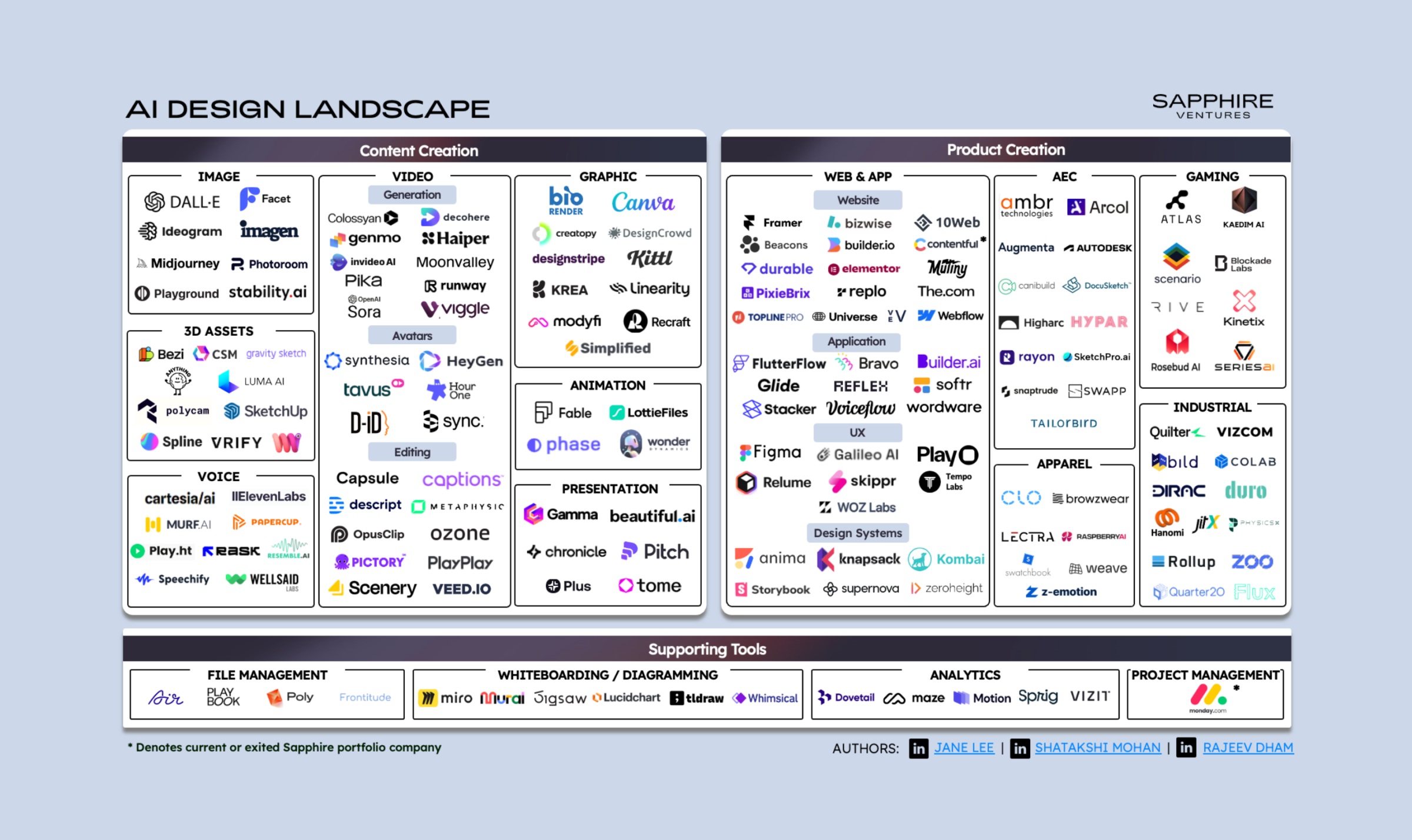Design is everywhere around us. It shapes everything we see, touch and buy—from the ads on your social media feed to the chair you’re sitting on and the home you live in. Design is rooted in the invisible processes and tools that bring our ideas to life, very often in ways we don’t immediately notice. The reach of design tools, especially design software, is immense and has played a pivotal role in creating some of the world’s most iconic companies. In this blog, we’re diving into the tools that have shaped design, the implications of AI on the space and what excites us most about the future of design.
Design Software: The Hidden Force Shaping the World & What’s Next

The Evolution of Design Tools
The design “greats” founded in the 1980s—Adobe ($200B+ market cap), Autodesk ($50B+ market cap), Cadence ($70B+ market cap) and Dassault Systemes (~$50B market cap)—each played a pioneering role in revolutionizing design. These companies facilitated the transition from manual to digital design by creating specialized software tools for their respective domains and grew to become the gold standard for generations of designers. However, the specialized nature and steep learning curves of these tools meant they were primarily suited for design professionals with deep technical knowledge. For example, it typically takes three to four months to become proficient in Photoshop.
In the last decade, the rise of design companies like Figma and Canva has played a pivotal role in the democratization of design. Thanks to the emergence of no-code, visual and collaborative user interfaces, design has become much more digestible, user-friendly and accessible. Design tools are no longer exclusive to professional designers. You no longer need to have pro Photoshop skills to design a poster. Today’s design software emphasizes usability with drag-and-drop interfaces and vast template libraries, enabling real-time collaboration across teams through browser-based platforms.
Looking forward, we expect the next wave of AI-native design software startups to further democratize design and supercharge productivity at an unparalleled pace. By leveraging generative AI to tackle the “blank page” paralysis, create hyper-personalized designs and automate costly and repetitive workflows, these companies will deliver unprecedented time to value, cost savings and creative breakthroughs.
How AI is Transforming the Design Industry 🤝
AI has had a transformative impact on the design industry. Here are our observations on how AI’s influence is unfolding:
- Massive Creative Explosion: Generative AI platforms such as Midjourney have made content creation cheaper, easier and faster. With AI models being more economical and quicker than human labor, there has been a tremendous surge in creative output from both professional designers and creative hobbyists. In fact, we think AI will eventually unlock a powerful flywheel effect: as more people are generating and experimenting with ideas more rapidly and efficiently, the overall pace of innovation will accelerate, leading to even more creative exploration and innovation.
- Conversational Everything: Gone are the days of navigating through countless buttons and icons to make an elaborate edit or create a functional prototype. Today, you can accomplish this task with a single line of written command, and voilà—the job is done. There is no need for Photoshop classes or learning new low-code languages. AI has brought forth an incredibly intuitive and conversational paradigm for completing design tasks.
- Multi-Modal Magic: With AI, users can seamlessly generate multiple modalities of content in one go. For example, with Gamma, you can generate a presentation, document or website from a single input. AI also makes it easy to repurpose existing content into new formats, such as turning a long-form video into Reels or Tiktoks, slicing a blog post into shorter, digestible articles or transforming a deck into a webpage.
- Goodbye Handoffs: AI has shaken up even established design processes by empowering individuals from diverse roles to own more aspects of the end-to-end design journey. For example, designers can generate code without relying on developers using tools like Framer, product managers can generate prototypes without designers and developers can gather user feedback without PMs.
Here’s what founders have to say about the immense potential of AI across various design disciplines:








The AI x Design Software Market 🚀
A dynamic and rapidly growing ecosystem of AI-driven solutions is reshaping design across various disciplines. Here are the players we’re keeping an eye on because of their innovative approaches to streamlining and enhancing the design process.
How AI is Disrupting Key Design Domains
Video 🎞️
Creating video content is more challenging than producing static images or text, as it requires representing motion and maintaining temporal coherence between consecutive frames. Solutions like Runway, Pika Labs and OpenAI Sora have emerged to address these challenges by generating videos from various inputs, including text, images and existing videos. These platforms offer customization options, allowing users to tailor the generated content—adjust the movement of elements, camera angles and styles to enhance realism. Tools like Synthesia and HeyGen specialize in generating AI human avatars with advanced capabilities such as lip sync, facial expressions, customizable appearances and multilingual support. A plethora of video editing software has also emerged, leveraging AI to automate various aspects of the post-production process, such as automated captioning, editing, dubbing, script creation and music integration. Descript provides powerful transcript-based editing for professional-level videos and Captions offers a comprehensive editing suite tailored for short-form content creation.
3D 💎
3D content is everywhere now, increasingly becoming a “standard” format alongside text, images and video. However, designing in 3D is a different ballgame. The complexity of accurately depicting objects in three-dimensional space requires specialized technical expertise. Kaedim and Luma AI are streamlining 3D asset generation from 2D images and prompts with a variety of possible 3D outputs that can cater to diverse use cases. Platforms like Bezi and Spline are revolutionizing the 3D design process with their Figma-esque functionality, offering extensive asset libraries, collaborative web-based workflows and no-code prototyping features to further democratize 3D creation.
Web 🖥️
New-age website builders across industries have incorporated a powerhouse of AI tools that can turbocharge the web design process. Framer allows designers to create responsive websites, add animations and publish all in one place, eliminating the need to rebuild from scratch in web development platforms and go back and forth between tools. Companies like Bizwise and Durable are powering websites for the long tail of SMBs and local service providers with additional business-in-the-box functionality such as CRM, scheduling and invoicing modules. Replo enables ecommerce merchants on Shopify to quickly build ultra-customizable landing pages without requiring intensive developer resources.
Industrial ⚙️
Industrial designers are often tasked with solving multifaceted design problems involving various technical constraints such as material properties, production methods and regulatory requirements, all while balancing cost and ergonomics. The process tends to be highly iterative, requiring continual refinement based on user testing and feedback. Platforms like PhysicsX enable designers to simulate and analyze the performance of designs in virtual environments under various conditions, identifying potential issues and design optimizations before the physical prototyping stage. Tools like Quilter and Vizcom produce high-fidelity prototypes and renderings from 2D sketches, schematic files or prompts. They also accommodate input parameters across functional requirements, material properties and manufacturing constraints.
Design as the Ultimate Differentiator
As investors, we’re excited not only by the advancements in design tools but also by the growing importance of design in company-building. Design is no longer relegated to mere aesthetics; being design-centric now means being customer-centric. Consider the success of design-first companies like Apple, Tesla and Airbnb: by making design a core pillar of their identity, these companies have delivered exceptionally intuitive and memorable product experiences, commanded higher willingness to pay and built enduring brand devotion. In fact, studies by the Design Management Institute and McKinsey provide compelling evidence on the tangible business impact of design. Organizations that prioritize design excellence consistently outperform their competitors, achieving higher rates of revenue growth and shareholder returns. We believe the space is growing faster than ever as more companies invest in robust design capabilities and integrate design practices throughout their operations.
If you’re building in this space, we’re all ears and would love to chat! Feel free to reach out to Jane at [email protected], Shatakshi at [email protected] and Rajeev at [email protected].
Also, a huge shoutout to Amar Hanspal, Grant Lee, Julian Park, and Sergiy Nesterenko for their collaboration and insights.
Nothing presented within this article is intended to constitute investment advice, and under no circumstances should any information provided herein be used or considered as an offer to sell or a solicitation of an offer to buy an interest in any investment fund managed by Sapphire Ventures (“Sapphire”). Information provided reflects Sapphires’ views as of a time, whereby such views are subject to change at any point and Sapphire shall not be obligated to provide notice of any change. Companies mentioned in this article are a representative sample of portfolio companies in which Sapphire has invested in which the author believes such companies fit the objective criteria stated in commentary, which do not reflect all investments made by Sapphire. A complete alphabetical list of Sapphire’s investments made by Its direct growth and sports investing strategies is available here. No assumptions should be made that investments described were or will be profitable. Due to various risks and uncertainties, actual events, results or the actual experience may differ materially from those reflected or contemplated in these statements. Nothing contained in this article may be relied upon as a guarantee or assurance as to the future success of any particular company. Past performance is not indicative of future results.


